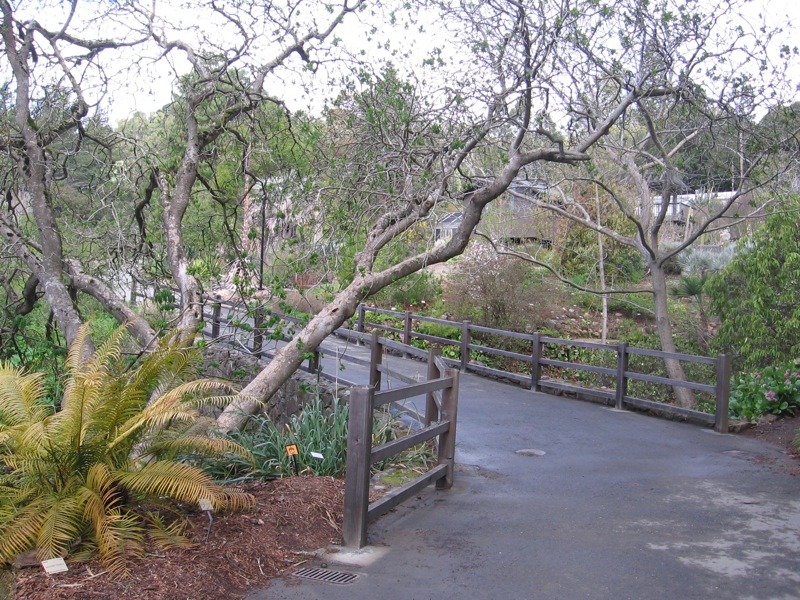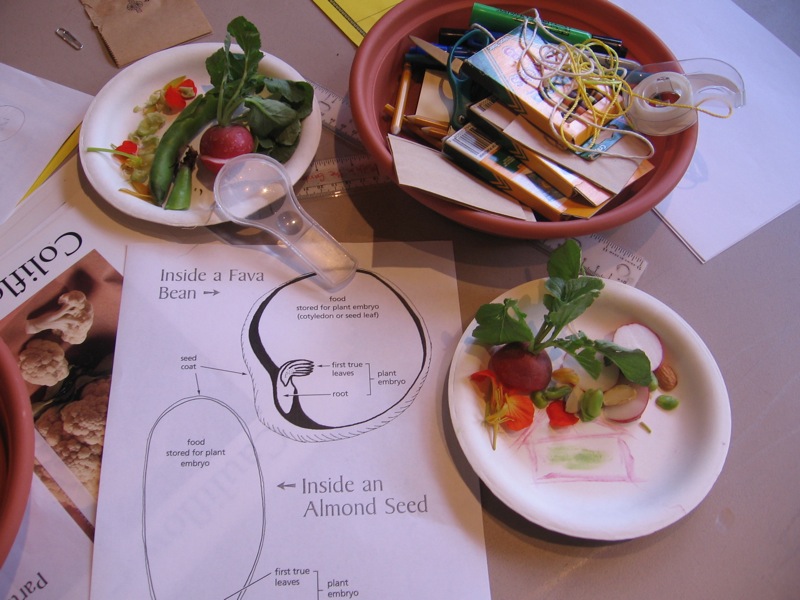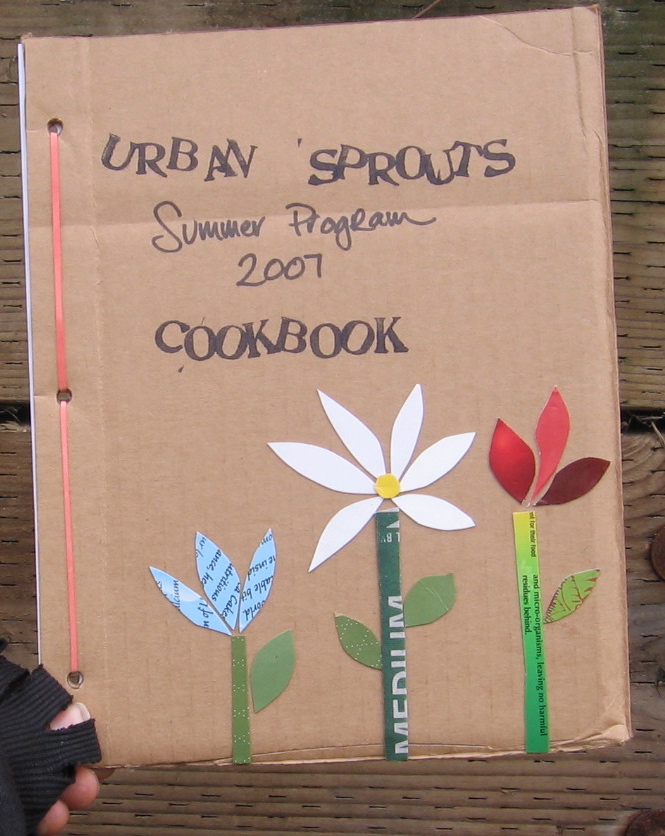San Francisco Chronicle's March 22nd paper featured a series of articles on urban farming. The many innovative approaches to growing food in an urban setting, such as school gardens, appear to be attracting the attention of city planners. The series ends with an invitation to us readers to share our own thoughts on urban farming with the Chronicle's Kitchen Gardener. Email them and share!
Tuesday, March 25, 2008
Wednesday, March 19, 2008
Keynote on School Gardens
 I was extremely honored to be asked to give the keynote speech at last Saturday's School Garden conference held by the UC Botanical Garden at Berkeley. The conference theme was successes and best practices, so I shared the Program Model and the story of how Michelle's research study on school gardens led to this framework that guides all Urban Sprouts' work. If you haven't yet visited this amazing botanical garden, go now!
I was extremely honored to be asked to give the keynote speech at last Saturday's School Garden conference held by the UC Botanical Garden at Berkeley. The conference theme was successes and best practices, so I shared the Program Model and the story of how Michelle's research study on school gardens led to this framework that guides all Urban Sprouts' work. If you haven't yet visited this amazing botanical garden, go now! Presentations at the conference included the Botanical Garden's Botany on your Plate curriculum, which you can now buy at their bookstore. We explored plant parts, and found that you can use radishes as giant pink crayons! We made root mash (like mashed potatoes) from six different root vegetables, and the most popular one was rutabagas!! Apparently rutabagas are becoming endangered because not enough people eat them. I found them delicious.
Presentations at the conference included the Botanical Garden's Botany on your Plate curriculum, which you can now buy at their bookstore. We explored plant parts, and found that you can use radishes as giant pink crayons! We made root mash (like mashed potatoes) from six different root vegetables, and the most popular one was rutabagas!! Apparently rutabagas are becoming endangered because not enough people eat them. I found them delicious. In my talk, I also brought up the history of school gardens in the US. Too few of us garden educators know our own history - that during World War I and II school gardens were identified as a major solution to the social issue of the day, national security.
In my talk, I also brought up the history of school gardens in the US. Too few of us garden educators know our own history - that during World War I and II school gardens were identified as a major solution to the social issue of the day, national security.Wartime threatened our food supply, and even Europe was dependent on US-grown food. The US School Garden Army enlisted "soldiers of the soil" to grow food at schools, to increase fruit and vegetable consumption, and to improve the health of the populace. This call that "food will win the war," was incredibly successful. Several million school children grew food in their school gardens, growing 40% of all fruits and vegetables eaten in the US. This was the time in our history when Americans ate the most fruits and vegetables, ever! I learned all this from Rose Hayden-Smith's fascinating work on the US School Garden Army. On her website you can see some of the old propaganda posters, including the one above, calling on children to serve their country in the school garden!
Think we can create such a mass mobilization today? School gardens can have a major impact on many current issues, beyond getting kids to eat more veggies and do better on standardized tests. Can you think big, and think of ways school gardens can make real change in our communities?
Labels:
curriculum,
evaluation,
gbemodel,
history,
school garden
Monday, March 17, 2008
Build an Urban Bee Garden
A brief but fascinating conversation with Dr. Rollin Coville, a UC Berkeley trained entomologist, led Urban Sprouts to the website for Urban Bee Gardens. For those of you interested in local and native pollinators, check it out! You can learn amazing information about bees such as:
Thank you Dr. Coville forguiding Urban Sprouts to this fun website!
- There are about 25,000 species of bees known worldwide.
- In the U.S. we have almost 4,000 species
- In California slightly more than 1,500 species have been recorded.
- In the East Bay cities of Albany and Berkeley 81 species of bees have been identified from residential neighborhoods.
Thank you Dr. Coville forguiding Urban Sprouts to this fun website!
Labels:
bees,
pollinators,
school garden,
urban garden
Wednesday, March 12, 2008
Love your Pollinators!
 You may be following the worrying news that honey bees are mysteriously disappearing in the US and worldwide, possibly due to a mix of diseases and insecticides. Here in California this seriously threatens our fruit and nut tree crops that depend on bees as pollinators. In fact, Einstein was quoted as saying if the bees go we'd last four years. (The photo at left shows a honey bee swarm we witnessed during the Summer Program at the Garden for the Environment. Click on it to see it bigger - can you see the bees?)
You may be following the worrying news that honey bees are mysteriously disappearing in the US and worldwide, possibly due to a mix of diseases and insecticides. Here in California this seriously threatens our fruit and nut tree crops that depend on bees as pollinators. In fact, Einstein was quoted as saying if the bees go we'd last four years. (The photo at left shows a honey bee swarm we witnessed during the Summer Program at the Garden for the Environment. Click on it to see it bigger - can you see the bees?) In our Urban Sprouts' school gardens it is obvious how important pollinators are to the health of our garden ecosystem! This week at June Jordan we reviewed plant reproduction and the important role pollinators play in the lives of many plants. Here is a photo of a daffodil we dissected in order to see all the parts involved in sexual reproduction.
In our Urban Sprouts' school gardens it is obvious how important pollinators are to the health of our garden ecosystem! This week at June Jordan we reviewed plant reproduction and the important role pollinators play in the lives of many plants. Here is a photo of a daffodil we dissected in order to see all the parts involved in sexual reproduction.You can see the stamens (male parts), each holding the pollen at their tips, and the pistil in the center (female part) the leads down to the ovary below. We have opened the ovary so you can see the seeds forming inside. The ovary holds the eggs, which once pollinated, grow into seeds. And the ovary swells to become . . . you guessed it, fruit!
Which leads to our favorite saying, how can you recognize a fruit? It has seeds inside!
So the point is that we need pollinators to get the pollen from one flower onto the pistil of another flower. Without pollinators like bees, many of our favorite plants can't produce flowers (or reproduce themselves in order to survive). For examples, think of anything you like to eat that is a fruit or a seed! Apples, pears, almonds, walnuts, tomatoes, squash, corn and even peas need pollination!
Labels:
bees,
curriculum,
flower,
pollinators,
school garden
Subscribe to:
Comments (Atom)








